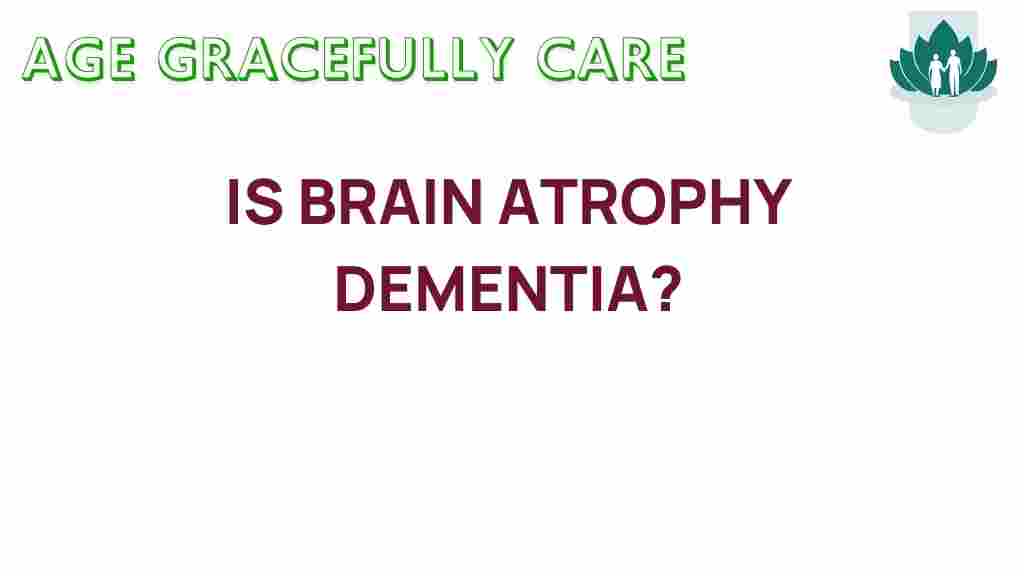Is Brain Atrophy a Hidden Trigger for Dementia?
As the world ages, the prevalence of neurological disorders, particularly dementia, is on the rise. One of the critical underlying factors that may contribute to this alarming trend is brain atrophy. While many people are aware of dementia as a debilitating condition characterized by cognitive decline, the connection between brain atrophy and dementia is less understood. In this article, we will explore the relationship between brain atrophy, dementia, and overall brain health as we age.
Understanding Brain Atrophy
Brain atrophy refers to the loss of neurons and the connections between them. It can occur due to a variety of factors, including aging, trauma, or neurodegenerative diseases. As the brain shrinks, it can lead to significant implications for mental wellness and cognitive function.
- Causes of Brain Atrophy:
- Aging
- Neurodegenerative diseases (e.g., Alzheimer’s, Huntington’s)
- Traumatic brain injury
- Chronic alcohol abuse
- Stroke
- Symptoms of Brain Atrophy:
- Cognitive decline
- Memory loss
- Difficulty with problem-solving
- Changes in mood and behavior
The Link Between Brain Atrophy and Dementia
Research has shown a strong correlation between brain atrophy and the onset of dementia, particularly Alzheimer’s disease. Brain atrophy often precedes the clinical symptoms of dementia, making it a potential early warning sign. Understanding this relationship can help in early diagnosis and intervention, potentially slowing down the progression of cognitive decline.
Types of Dementia Associated with Brain Atrophy
There are several types of dementia, and brain atrophy is particularly associated with the following:
- Alzheimer’s Disease: Characterized by significant shrinkage in specific areas of the brain, especially the hippocampus, which is critical for memory.
- Frontotemporal Dementia: Involves atrophy in the frontal and temporal lobes, affecting personality, behavior, and language.
- Vascular Dementia: Often results from strokes or other conditions that affect blood flow to the brain, leading to atrophy in various regions.
Risk Factors for Brain Atrophy and Dementia
Aging is the most significant risk factor for both brain atrophy and dementia. However, several other risk factors can exacerbate the decline in neurological health:
- Genetics: Family history of dementia can increase your risk.
- Cardiovascular health: Conditions like hypertension and diabetes can affect brain health.
- Educational level: Higher levels of education may provide cognitive reserve.
- Lifestyle choices: Poor diet, lack of physical activity, and smoking can contribute to brain atrophy.
Recognizing Cognitive Decline
Identifying the early signs of cognitive decline is crucial for intervention. Some early symptoms include:
- Forgetfulness that disrupts daily life
- Difficulty concentrating or following conversations
- Confusion with time or place
- Changes in mood or personality
If you or a loved one is experiencing these symptoms, it’s essential to consult a healthcare professional for a thorough assessment.
Step-by-Step Process to Support Brain Health
While we cannot prevent aging, there are proactive steps we can take to support brain health and potentially mitigate the effects of brain atrophy:
1. Engage in Regular Physical Activity
Exercise is crucial for maintaining overall health, including brain health. Aim for at least 150 minutes of moderate aerobic exercise each week.
2. Maintain a Balanced Diet
A diet rich in fruits, vegetables, whole grains, and healthy fats promotes brain health. Consider incorporating:
- Omega-3 fatty acids (found in fish, walnuts, and flaxseeds)
- Antioxidants (found in berries and dark chocolate)
- B vitamins (found in leafy greens and legumes)
3. Stay Mentally Active
Challenge your brain with puzzles, reading, learning new skills, or playing musical instruments. Keeping your mind active can help build cognitive reserve.
4. Social Engagement
Maintaining strong social connections can reduce the risk of cognitive decline. Engage in community activities or stay in touch with family and friends.
5. Manage Chronic Conditions
Control conditions such as diabetes, hypertension, and high cholesterol to reduce risk factors associated with brain atrophy.
Troubleshooting Tips for Brain Health
If you’re concerned about brain atrophy and dementia, consider the following troubleshooting tips:
- Regular Check-ups: Schedule regular visits with your healthcare provider to monitor cognitive health.
- Seek Cognitive Assessment: Use cognitive screening tools to assess your mental wellness.
- Consider Genetic Testing: If you have a family history of dementia, discuss genetic testing with your doctor.
- Mindfulness and Stress Management: Practice mindfulness, meditation, or yoga to reduce stress, which can impact brain health.
Conclusion
In conclusion, brain atrophy is indeed a hidden trigger for dementia that warrants attention. Understanding the relationship between brain atrophy and cognitive decline is crucial for early diagnosis and intervention. By recognizing risk factors and adopting a proactive approach to neurological health, individuals can engage in practices that support their mental wellness as they age. The journey to better brain health is ongoing, and small changes can lead to significant benefits in the long run.
For more information on maintaining optimal brain health and preventing dementia, consider visiting trusted resources such as the Alzheimer’s Association and explore their materials on brain health.
Additionally, if you want to dive deeper into strategies for enhancing cognitive function, check out our comprehensive guide on cognitive health strategies.
This article is in the category Health and created by AgeGracefullyCare Team
